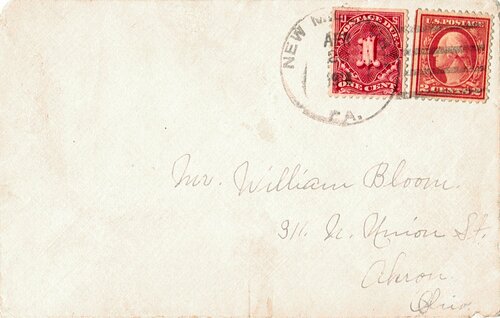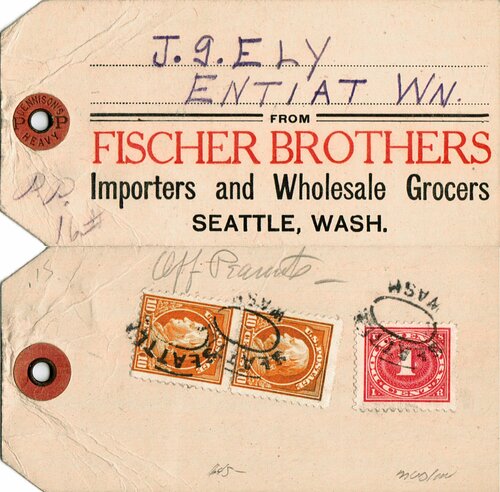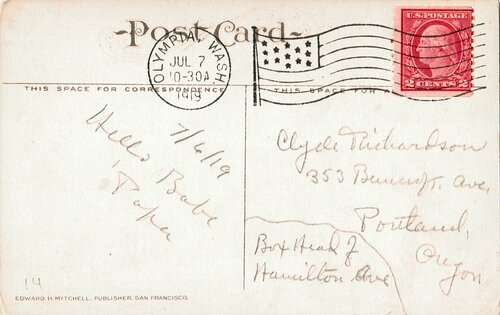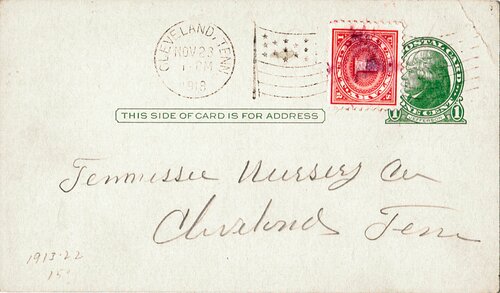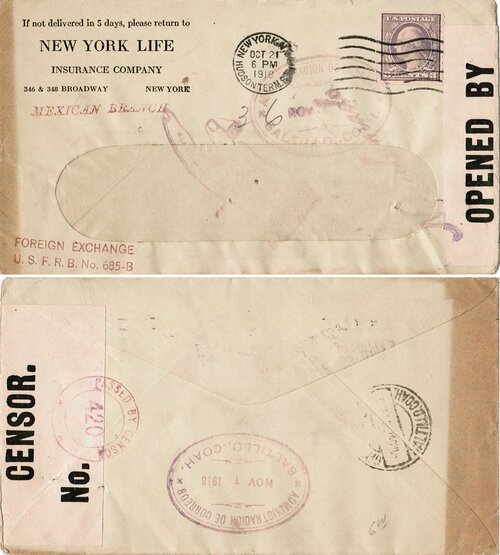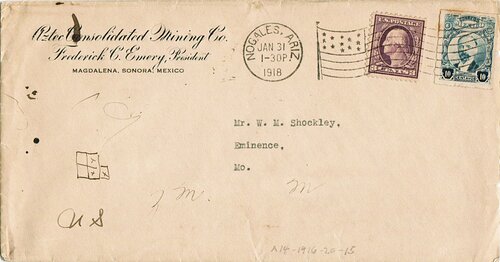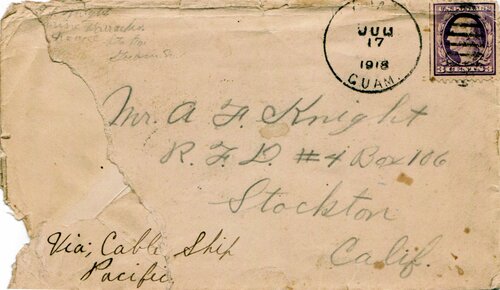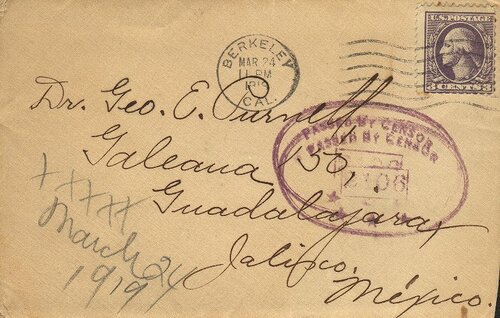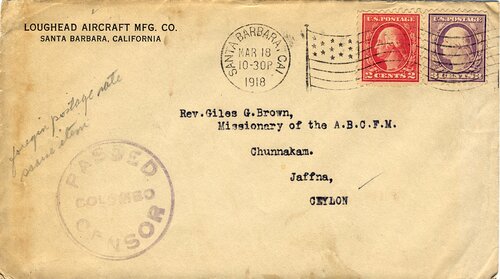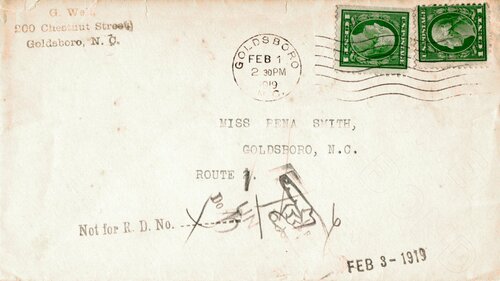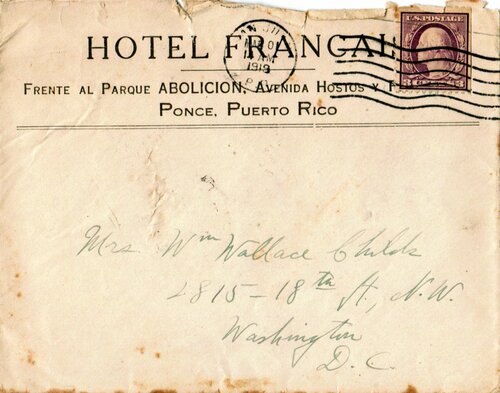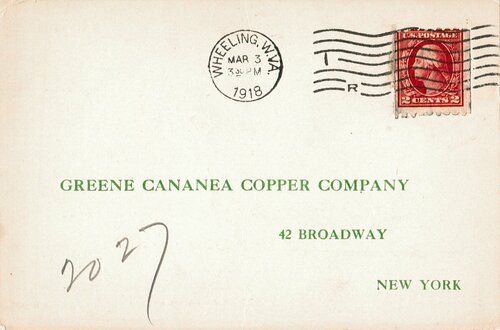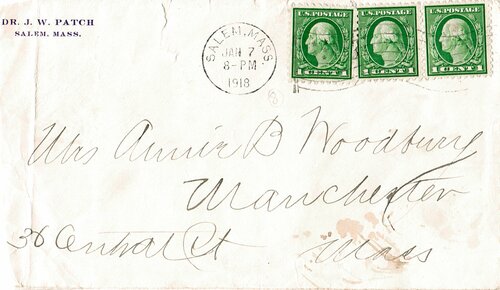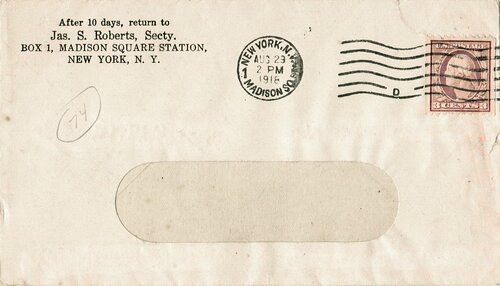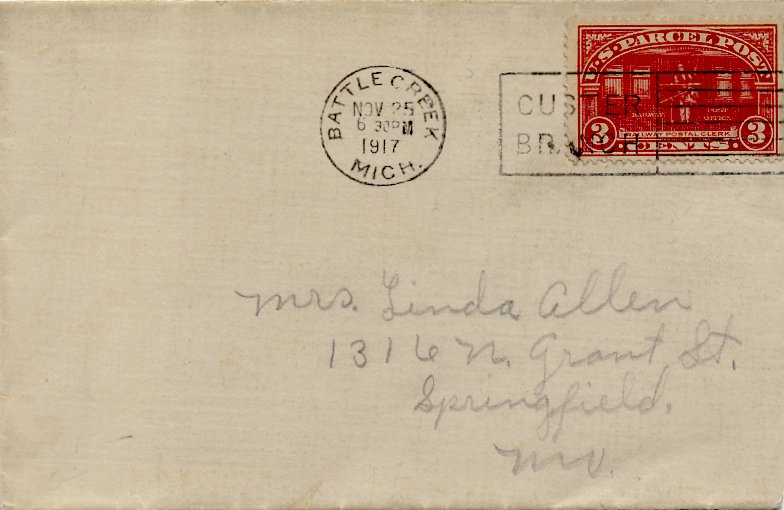
Parcel Post Stamp Used in 1917
These images illustrate the usages I’ve seen of the rates imposed in the U. S. during the First World War.
The United States, like several other countries, raised money to cover the costs of the First World War. One way these costs were recovered, was to increase postal rates. Thus, in late 1917, the first class letter rate went from 2 cents to 3 cents. There were other postal increases as well.
Many of the items shown are of civilian origin, rather than from military personnel within the United States. November 2, 1917 marks the first day of the new ‘war’ rates. First-class letters increased from 2 cents to 3 cents, a 50% jump. For postcards, the mailing rate doubled. (This took place during the ‘postcard craze’ of the early 20th Century.)
At the time of the change, the Post Office’s stock of 2-cent stamps was large, but 3-cent stamps were hard to find.
For this reason, collectors often find covers and cards carrying older stamps. People must have dug deeply into their desks (and postmasters must have looked long and hard through their stamp drawers) to meet the new rates.
We also see ‘old’ stamps used during this time period, stamps that had not seen the light of day for many years.
Interestingly, overseas rates did not change, as well as extra charges, such as Special Delivery and Registration. In addition, rates to foreign countries (set by postal treaty) also did not change.
Special rates were established for mailings overseas to the War zone, with first-class letters to soldiers being the same 3 cents as a letter across the country.
You will also see a special ’local’ rate demonstrated here. If a first-class letter was addressed to a recipient within the same Post Office area, it was considered ’local’, and only cost 2 cents. However, any letter sent out of the local Post Office area required the extra cent postage. Failure to handle this rate caused a ‘postage due’ charge, particularly on items that were forwarded out of the local Post Office area.
Quite rare, but very collectible, are usages of Parcel Post during this era, as U. S. revenue stamps were required on parcels to pay the ’tax’ in addition to the postage.
Note that the 3-cent stamps issued before the rate increases are not seen commonly on mail from the War era. After the rate increase, the BEP and Post Office worked very hard to issue billions of stamps with this value.
I will use the Scott (tm) numbering system to identify the stamps illustrated here (the numbering is the sole property of Scott Publishing).
Illegal Use of Postage Due Stamp to Make Up WWI War Rate --- It was well-known that the first class letter rate was 3 cents, but apparently the sender decided that the ‘postage due’ stamp was worth one cent.
Parcel Post Tag with Revenue Stamp (WWI) --- Part of the WWI war rate taxes included a tax on Parcel Post packages.
WWI War Rate Stamp Use After Rates Removed --- The WWI war rates for postcards and letters were active until July 1, 1919.
Revenue Stamp Used as Postage Due on Postal Card --- With the postcard rate increased to 2 cents in late 1917, users were supposed to add postage to these very common one cent cards.
Patriotic Advertisement Cover --- This is a 3rd class advertisement mailing, as indicated by the 1-cent rate, and the ‘mute’ machine cancel.
Commercial Mail Sent to Mexico with Foreign Exchange Handstamps --- This cover was both censored and treated to additional scrutiny during the First World War.
Foreign Rate Using Postal Envelope and 2-Cent Stamp, with Added Customs Markings --- A 2-cent stamp was added to the 3-cent postal envelope to cover the rate to Suriname (South America).
Mixed Franking, Cross-Border from Mexico --- This cover has postage from both Mexico and the U. S.
First World War Mail from Guam --- This cover was mailed on Guam in 1918, a very rare mail origin.
New Three Cent Rate Supplied by Parcel Post Stamp --- This usage of a Parcel Post stamp to cover the WW I war rate may be unique.
Mail to Mexico, No Rate Difference (Censored) --- This cover was mailed from Berkeley, California in 1919 to Mexico.
Overseas Mail, No Rate Difference (Censored) --- This cover was mailed from Santa Barbara, California in 1918 to Ceylon.
Local Rate on Cover Sent to an RFD Address --- This item is franked with two cents postage, because it was addressed ’locally'.
Postcard Cancelled on the First Day of the War Rate --- The United States increased postage rates on November 2, 1917 to cover costs of WWI.
Regular First Class Rate from Puerto Rico --- This cover, while a bit ratty, shows the WWI War Rate (three cents for a first-class letter) used from Puerto Rico to Washington, DC.
Mailed to Local Address, Forwarded, Causing Postage Due --- This local rate letter was addressed within Providence, Rhode Island, but was forwarded to an address ourside the local area.
Postage Due, Addressee Not Local --- This letter was sent from the main Post Office in St. Louis, Missouri to a small village nearby (Florissant, later a suburb).
Old Stamp (Scott Number 411) --- This is a very uncommon use of the flat plate coil stamp, perforated 8 1/2 horizontally (Scott #411).
Use of 'Old' Stamp on Dental Bill (Scott Number 462) --- Civilian cover from a dentist, containing their bill.
Early War-Rate Cover Using 3 Cent Coil (Scott Number 489) --- Civilian cover using an ‘old’ stamp; that is, a stamp issued before the new War Rates came into effect in 1917.
Early War-Rate Cover Using 3 Cent Coil (Scott Number 493) --- Civilian cover using an ‘old’ stamp; that is, a stamp issued before the new War Rates came into effect in 1917.
Local Rate Using a Washington Coil Stamp (Scott Number 492) --- Civilian cover using an ‘old’ stamp; that is, a stamp issued before the new War Rates came into effect in 1917.
Use of Reply Postal Card with Added Stamp --- This is a usage of a reply postal card during the First World War.
More Links
Back to WWI General Information
Back to WWI Postal History Page
Go back to the Swanson homepage.
Technical Information
Uses PaperMod theme of Hugo (see footer of this page)
Updated Tue 27 Feb 2024 03:43:34 PM CST
